An exhibition by the German Historical Museum
With the financial support from: The Federal Commissioner for Cultural and Media Affairs
The former Reichssportfeld, built for the XI Olympic Games in 1936, is an important and yet difficult site. The documentary exhibition on the Olympic grounds offers information on the various phases in its construction and use. The Langemarckhalle at the foot of the Bell Tower is placed in this historic context for the first time.
The documentary exhibition is made up of five parts:
1. Sport, Society and Politics
The first part deals with the way in which the role of sport has changed in German society. It takes us from the beginnings of the German gymnastics movement in the Nineteenth century to the workers' sport movement and the increasing popularity of sport coming from Great Britain to the Nazi Gleichschaltung (synchronisation) of sport culture.
|

Friedrich Ludwig Jahn, “Father of Gymnastics”, litho, 1889 ©DHM
|
2. The Olympic Games 1936
The second part concentrates on the event leading to the extension of the grounds and the buildings still maintained to the present day: the 1936 Olympic Games. Here the focus is on the Nazi propaganda machine's effective staging of the Games for both the masses and the media.
|
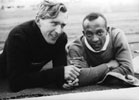
Jesse Owens (USA) and his main rival Luz Long (Germany) during a break in the long-jump competition, 4 August 1936 ©DHM |
3. Building History of the Olympic Grounds
Part three illustrates the various stages in construction. The main part of this section is a 3D animation film, showing in fast motion the individual stages since the beginning of the Twentieth century in the building, extension and modification of the grounds.
|
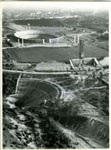
Reichssportfeld, 1936
©DHM/Hans Schaller
|
4. The Use of the Grounds up until the present Day
The fourth part focusses on the use of the grounds up until the present day. The site united excellent sporting facilities with the Maifeld, intended for mass rallies, and the Langemarckhalle, dedicated to the hero cult and remembrance of the fallen. The Olympic Stadium today hosts two major sporting events: the Internationales Stadionfest (ISTAF) and the German Football League Final attract tens of thousands of visitors every year.
|
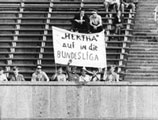
Bundesliga promotion match 1967: Hertha fans at the match between Hertha BSC and Borussia Neunkirchen,
4 June 1967 ©DHM/Sammlung Schirner |
5. The History of a Myth
The fifth and final part of the exhibition gives a commentary on the origins and history of the Langemarck myth. This has its origins in the First World War as a glorification of the supposedly willing sacrifice of life by young volunteers in a failed military offensive.
|
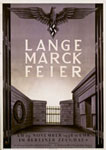
Poster announcing a Langemarck commemoration at the Zeughaus in Berlin, November 1938 ©DHM |

“I Summon the Youth of the World”
A compilation film with some hitherto unknown material from the time is shown for extra information. The journalist and longstanding ZDF editor Reinhard Appel accompanies the film. His experiences as a young man – as one of the spectators at the Olympic Games and as a Hitler youth stationed at the Reichssportfeld in the last days of the war – are representative of the experiences of an entire generation.
Address
Grandstand building below the Bell Tower
Am Glockenturm
14053 Berlin-Charlottenburg-Wilmersdorf
Link: www.glockenturm.de
Visiting
S-Bahn (S5, S75): S-Bhf. Pichelsberg
Bus: 149, 218 (Bus stop: Ragniter Allee)
By car: from Heerstraße, Glockenturmstraße or Passenheimer Straße; from the North via Reichsstraße, Olympische Straße, past the Olympic Stadium to Jesse-Owens-Allee and Passenheimer Straße
Parking: Straße Am Glockenturm
Opening hours
1 April – 31 October, 9.00 am – 6.00 pm
Further information
+49 (0)30 305 81 23
As of: April 2006
Exhibition Plan
Ground Floor

First Floor
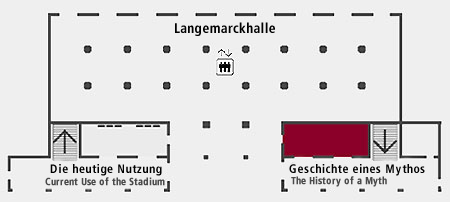
Panoramic views of the exhibition
Publication
A publication on the exhibition is available from jovis Verlag
ISBN 3-936314-66-7 (German edition)
ISBN 3-936314-33-0 (English edition) |
 |
Concept and realisation of the exhibition:
Deutsches Historisches Museum
Unter den Linden 2
10117 Berlin
www.dhm.de
|
